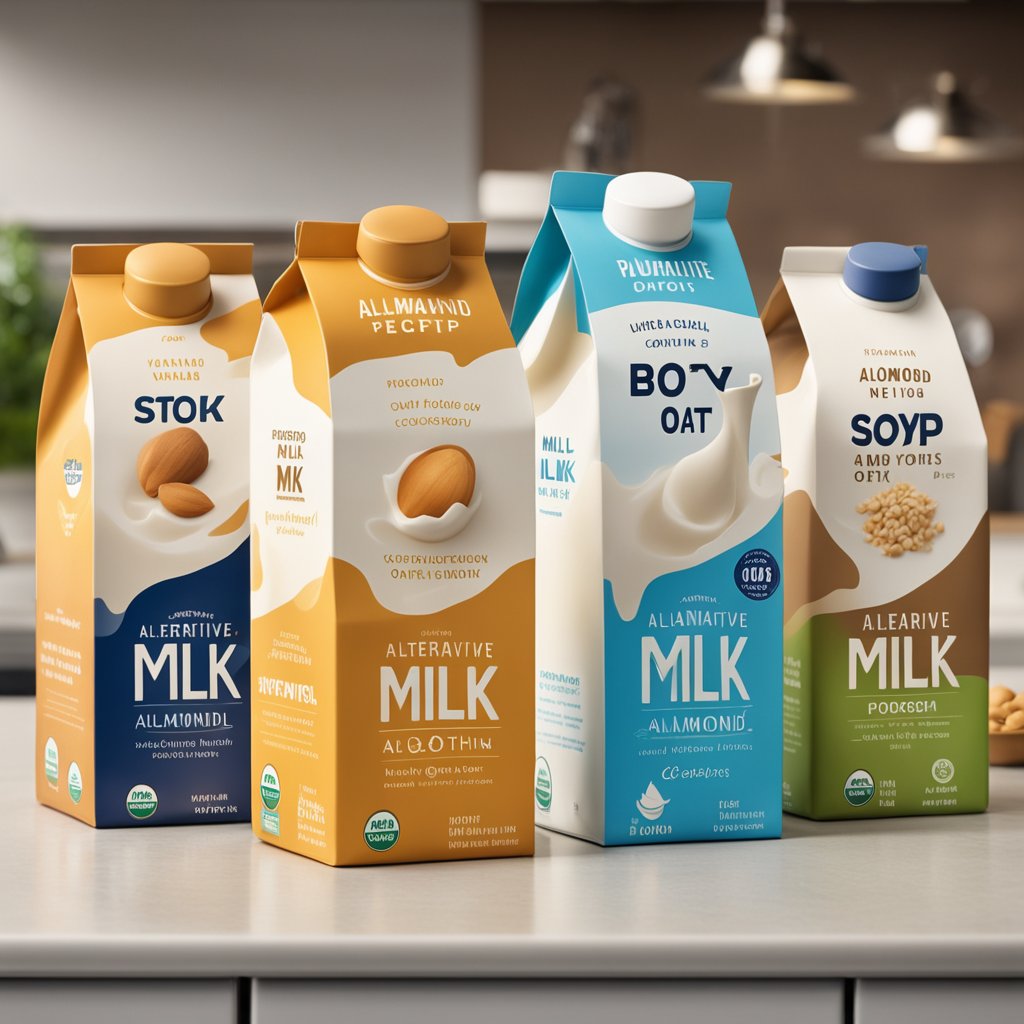Table of Contents
How to Choose Keto-Friendly Milk Alternatives
Are you looking for keto-friendly milk alternatives? Our step-by-step guide, “How to choose keto-friendly milk alternatives,” is here to help you make the right choices. In this guide, we’ll walk you through the process of finding milk alternatives that are low in carbs, high in healthy fats, and perfect for your ketogenic lifestyle. Say goodbye to regular milk and join the keto revolution!
Understand your keto-friendly milk alternatives options
There are several keto-friendly milk alternatives available that can be incorporated into your diet. Here are three popular options along with their nutritional content and how they fit into a keto diet:
- Almond Milk
- Nutritional Content: Almond milk is low in carbs and calories, making it a great choice for keto diets. It contains healthy fats, vitamins (such as vitamin E), and minerals (such as calcium).
- Keto Diet Fit: Almond milk is a versatile option that can be used in cooking, baking, or as a dairy milk replacement in your morning coffee or smoothie. It is low in carbs, which makes it suitable for a keto diet.
- Coconut Milk
- Nutritional Content: Coconut milk is rich in healthy fats, specifically medium-chain triglycerides (MCTs), which are easily converted into ketones by the body. It also contains important minerals like manganese and copper.
- Keto Diet Fit: Coconut milk is an excellent choice for a keto diet due to its high fat content. It can be used in various recipes, including curries, soups, and desserts, to add creaminess and flavor.
- Flax Milk
- Nutritional Content: Flax milk is a good source of omega-3 fatty acids, fiber, and protein. It also contains vitamins and minerals like vitamin B12 and calcium.
- Keto Diet Fit: Flax milk is a low-carb and low-calorie option that can be enjoyed on a keto diet. It can be consumed on its own or used as a base for smoothies, cereals, or baking recipes.
Remember, when choosing any milk alternative for a keto diet, it’s essential to check the labels and opt for unsweetened varieties to avoid unnecessary carbs. Incorporating these keto-friendly milk alternatives into your diet can provide you with a delicious and nutritious way to enjoy dairy-free options while staying on track with your keto lifestyle.
Check for added sugars and carbohydrates
It’s important to be mindful of the amount of added sugars and carbohydrates in milk alternatives, especially if you’re trying to reduce your intake of these nutrients. To make informed choices, it’s crucial to check the labels and understand how to identify hidden sugars and carbs in the ingredient list. Here are some tips to help you do that:
- Read the nutrition facts panel: Look for the total amount of sugars and carbohydrates per serving. Keep in mind that natural sugars, such as those found in fruits, are not considered added sugars.
- Check the ingredients list: Look for terms like “sugar,” “high fructose corn syrup,” “honey,” or other sweeteners. These indicate the presence of added sugars. Similarly, words like “flour,” “starch,” or “maltodextrin” indicate the presence of carbohydrates.
- Watch out for alternative names: Some ingredients may have different names that you might not recognize as sugars or carbs. For example, ingredients like “dextrose,” “fructose,” or “sucrose” are all different forms of sugar.
- Pay attention to serving sizes: Remember that the nutrition information is typically based on a specific serving size. Be mindful of how much you consume in one sitting to accurately calculate your sugar and carb intake.
By being aware of the added sugars and carbohydrates in milk alternatives, you can make better choices that align with your dietary goals. Checking labels and understanding the ingredient list will arm you with the knowledge needed to make informed decisions about what you consume.
Consider fat content and quality
When following a ketogenic diet, fat consumption is crucial. Since the goal is to shift your body into a state of ketosis where it burns fat for energy, you need to make sure you’re getting enough fat in your diet. Fat is the primary source of fuel in a keto diet, and it helps keep you feeling satisfied and full between meals. It also plays a key role in supporting various bodily functions, such as hormone production and nutrient absorption.
Choose milk alternatives with higher fat content and opt for healthy fats
When it comes to milk alternatives on a keto diet, it’s important to consider the fat content. Regular cow’s milk is relatively high in carbohydrates, which can hinder ketosis. Fortunately, there are plenty of milk alternatives available that are low in carbs and higher in fat. Look for options like almond milk, coconut milk, or macadamia nut milk, which provide a creamy texture and contain healthy fats.
To further boost the fat content in your milk alternative, consider adding healthy fats like MCT oil or avocado oil. MCT oil is a type of fat that is easily converted into ketones, making it a popular choice among keto dieters. Avocado oil, on the other hand, is rich in monounsaturated fats, which have been linked to various health benefits. Simply add a tablespoon or two of these oils to your milk alternative of choice for an extra dose of healthy fats.
By paying attention to the fat content in your keto diet and choosing milk alternatives with higher fat content, you’ll be well on your way to achieving your weight loss and health goals. Don’t forget to incorporate healthy fats like MCT oil or avocado oil to further enhance the nutritional value of your meals and beverages.
Look for fortified options
When it comes to selecting milk alternatives, it’s important to look for options that provide the same nutrients as traditional dairy milk. Many milk alternatives on the market today are fortified with essential nutrients like calcium, vitamin D, and B12 to ensure that you’re getting a well-rounded nutritional profile. Here are some reasons why you should consider fortified milk alternatives and examples of common ones:
- Calcium: Calcium is important for maintaining strong bones and teeth. Look for milk alternatives that are fortified with calcium to ensure you’re getting an adequate amount. For example, almond milk and soy milk are often fortified with calcium, providing a similar amount as dairy milk.
- Vitamin D: Vitamin D helps your body absorb calcium and is essential for bone health. Fortified milk alternatives can be a good source of this nutrient, especially if you don’t get much sun exposure. For instance, oat milk and rice milk are commonly fortified with vitamin D.
- B12: Vitamin B12 is important for nerve function and the production of red blood cells. While it is naturally found in animal products, you can find fortified milk alternatives that provide this nutrient. For example, coconut milk and hemp milk are often fortified with B12.
By choosing milk alternatives that are fortified with these essential nutrients, you can ensure you’re getting a well-rounded nutritional profile.
Taste and personal preference
- Experiment with Flavors and Brands: Start by selecting a few different keto-friendly milk alternatives from your local grocery store or health food market. Look for options such as almond milk, coconut milk, or hemp milk. Begin your taste testing adventure by pouring a small amount of each milk alternative into separate glasses.
- Savor the Flavors: Take a moment to observe the color and consistency of each milk alternative. Then, raise one glass to your lips and take a small sip. Pay attention to the taste and texture, noting any unique flavors or aftertastes. Does the milk alternative have a creamy consistency, or does it lean more towards being watery? Does it have a distinct nutty flavor or a subtle sweetness? Make a mental or written note of your observations.
- Compare and Contrast: After sampling each milk alternative individually, take a moment to compare and contrast your experiences. Consider which flavors and textures appeal to you the most. You may find that you prefer the creaminess of almond milk, the tropical notes of coconut milk, or the earthiness of hemp milk. Remember, everyone’s taste preferences are different, so trust your own judgment.
- Refine Your Selection: Once you have identified your favorite keto-friendly milk alternatives, it’s time to dive deeper into the world of brands. Purchase a few different brands of your preferred milk alternative and repeat the taste testing process. This will allow you to discover subtle differences in flavor, sweetness, and overall quality.
- Enjoy Your Perfect Keto-Friendly Milk Alternative: By experimenting with different flavors and brands, you will be able to find the keto-friendly milk alternative that best suits your personal taste and preferences. Whether you enjoy it in your morning coffee, pour it over cereal, or use it in your favorite recipes, savor the satisfaction of knowing you have found the perfect match for your keto lifestyle. Cheers to your delicious and nutritious milk alternative discovery!
Making the right choice
In conclusion, choosing a keto-friendly milk alternative requires a bit of knowledge and consideration. By understanding your options, checking for sugars and carbs, considering fat content and fortification, and ultimately finding a milk alternative that you enjoy, you can successfully incorporate these beverages into your ketogenic lifestyle. Remember, the key is to make informed choices that align with your dietary goals, while still enjoying the taste and benefits of a delicious milk substitute. Cheers to finding the perfect keto-friendly milk alternative for you!


I’m curious about hemp milk. Has anyone tried it? How does it taste?
I’m a fan of almond milk, but I’ll definitely try some of the other options mentioned here.
It would be helpful if the article included information on the nutritional values of each milk alternative.
It’s great to see that there are so many dairy-free options for people on a keto diet. Thanks for sharing!
Great article! I never knew there were so many keto-friendly milk alternatives to choose from.
I’ve been on a keto diet for a while now, and finding good milk alternatives has been a struggle. Thanks for this informative article!